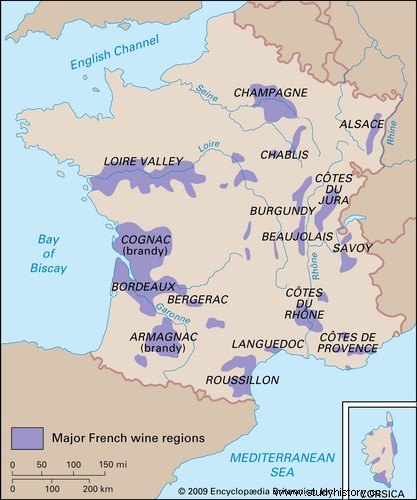Armagnac , Southwest Historical Region France , is now in Department Gers. It is a hilly region reaching 300m in height, drained by the Gers and other rivers that fan out from the Lannemezan Plateau. On the slopes of its hills grow the grapes from which the famous Armagnac Brandy .

Armagnac was in Merovingian and Carolingian times Part of the Duchy of Gascony and became in the 10th century to a autonomous political entity. From the 12th century it gained as a buffer zone between those controlled by the kings of France (Toulouse) and those controlled by the kings England (Guyenne) controlled areas of strategic importance . Their counts used their position to change loyalty and became very independent. The The Treaty of Calais (1360) during the Hundred Years War (1337–1453) gave the English sovereignty over Armagnac; An invocation of the Armagnac counts Jean I against English rule (1368) gave Charles V of France an excuse to resume this war.
During the 14th century, the Earls of Armagnac greatly increased their holdings. By the beginning of the 15th century, their lands ranged from the Garonne to the Pyrenees and also included parts of the Massif Central .
The location of his holdings and the services of the Gascon mercenaries made it possible for Count Bernard VII. Plays an important role in France's internal conflicts in the early 15th century. The The Armagnac party was used against the burgundy following the assassination of Louis, Duke of Orléans (brother of the mad King Charles VI), by John the Fearless , Duke of Burgundy (1407). Bernard came to the head of the Orleanist party with his daughter's marriage to the victim's son. Since the Burgundians often allied themselves with the English, the Armagnacs appeared to be a national faction, but were essentially a power-seeking group. From 1413 they gained control of the Mad King. Bernard was appointed policeman, chief of the army and governor of all finances. The Armagnacs led the resistance against the Invasion of the English King Henry V in France but suffered in the Battle of Agincourt a setback (1415). The Burgundians benefited from the discontent caused by the harsh Armagnac government. They entered Paris in the summer of 1418 and killed Bernard and many of his supporters. After 1418, the Armagnacs quickly lost power when the new king Charles VII The lead was taken by and itself with Charles reconciled the Bold, Duke of Burgundy.
Counts gradually lost their regional position. In 1473 a royal army captured their capital, Lectoure, and Count John V was killed. After the death of his brother Charles in 1497, the county of Charles VIII . With united with the Crown of France . Francis I of France, however, lent it to another Charles (nephew at last count) and at the same time gave him his sister Margaret in marriage. After the death of her husband, by whom she had no children, Margaret married Henry II of Navarre; and so the county of Armagnac reverted to the French crown along with the other dominions of her grandson, who became King of France as Henry IV (1607). During the 17th and 18th centuries, Armagnac existed as an administrative division of gouvernement-général by Guyenne et Gascogne.
